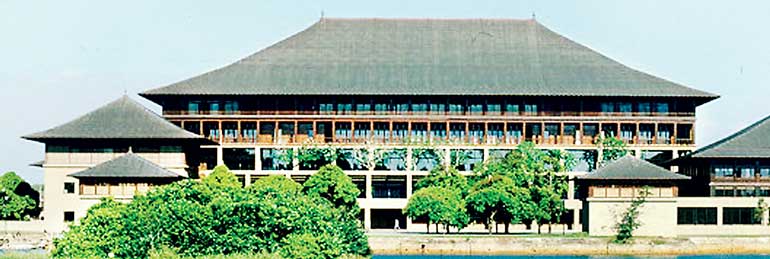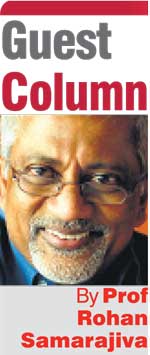Friday Dec 26, 2025
Friday Dec 26, 2025
Friday, 12 June 2015 00:00 - - {{hitsCtrl.values.hits}}

Having to collect votes from multiple ethnic and ideological constituencies within a large electorate is theoretically more likely to produce inclusive politicians
Electoral reform was an important element of the Common Candidate’s Manifesto. As independent intellectuals, we were impressed by how many political parties and organisations had signed on to change the electoral system but were concerned that it would be difficult to implement within the 100-day period. We set out to support the process by assembling and communicating evidence from past voting patterns and international experience.
In the very first public meeting we convened at the Nagarodaya Centre in Borella on 2 March, we analysed three scenarios based on the solution proposed by the Parliamentary Select Committee chaired by Dinesh Gunawardene, MP, and the New Zealand solution. This analysis was also published in the Financial Times on 3 March and in Ravaya on 7 March.
The scenario with the smallest number of electorates had 125 elected first-past-the-post (FPP); 75 elected on the basis of proportional representation (PR) applied to remainder votes at the district level and 25 elected by PR applied to the national vote as at present. In the course of the lively discussion, we came to understand the considerable difficulties of reducing the number of electorates from the 160 polling divisions, including multi-member constituencies, which had continued to live in our minds and in the practices of the Department of Elections and the political parties, though not in the Constitution.
To us, as policy analysts, what was of paramount importance was the ratio between FPP seats and seats filled through various PR methods. But we became convinced that reducing the number of electorates would be an extraordinarily difficult task unless all political parties took the responsibility of explaining and defending the required radical delimitation exercise. We were also convinced in the course of subsequent discussions of the likely negative implications for small parties with geographically dispersed constituencies, especially those representing Indian-origin Tamils in the Central, Uva and Sabaragamuwa Provinces.
From MMM to MMP
In the weeks that followed, the focus shifted from the PSC solution, which was a variant of a Mixed Member Majoritarian (MMM) model, to a variant of the Mixed Member Proportional (MMP) model. Here, the number of seats that a party would be entitled to in an electoral district is determined by PR applied to the votes cast for the candidates put forward by that party in that district. Who would occupy those seats would be determined primarily by who were victorious in the newly-demarcated electorates on a FPP basis. For the system to work, the number of seats for an electoral district had to be greater than the number of electorates within it. In addition to FPP winners, persons from district lists and “best losers” would also be assigned seats in Parliament that had been determined by PR.
This method may be illustrated with reference to a hypothetical electoral district entitled to 20 seats in total. Assume that after excluding votes of the parties that garnered less than five percent of the total votes cast in that district, Party A is entitled to 10 seats, Party B to eight seats and Party C to two seats. Assume also that the district had 12 electorates or more or less equal size, from which Party A produced eight FPP winners, Party B four FPP winners and Party C none.
Eight of the 10 seats won by Party A would be assigned to its FPP winners. The next seat would assigned to the first additional person on that party’s district list. The remaining seat would be assigned to its losing candidate who had gained the highest percentage of votes in an electorate.
In the case of Party B, four of the eight seats would be assigned to its four FPP winners. The remainder would be assigned to additional persons from the district list and “best losers” alternatively.
Party C, which had failed to win even a single electorate based on FPP, is still entitled to two seats based on the proportion of votes cast in the district. The first of those two seats would be filled from the district list and the second by the “best loser.”
Simulations based on past voting patterns showed that there would be complications such as more FPP winners than available seats for a party in a district, described as “overhangs.” Solutions were devised for this problem by creating a buffer through a variable national-list allocation. FPP winners who could not find a seat within their district allocation would be assigned a seat from their party’s national-list allocation.
This MMP-LK solution was novel in that it accommodated the heterogeneity of our population distribution by district and also made room for “best losers.” In New Zealand, MMP is implemented at the national level and all additional persons who are elected other than through FPP come from political-party lists.
It was proposed that the above solution should be supplemented by the creation of an adequate number of multi-member electorates to accommodate the interests of geographically dispersed minorities.
The 225 solution
What is important for the successful implementation of MMP-LK is the availability of adequate “additional persons” seats to accommodate the overhangs and underhangs, not the number of FPP electorates per se. In the previous proposal that had a total of 255 MPs being returned to Parliament which many political parties took as their reference point for discussion until this week, for one FPP seat there were 0.55 additional-person seats (165 by FPP and 90 filled from national and district lists and by “best losers”).
In the current proposal, which is not fully fleshed out, the ratio could be (a) 0.8 additional-person seats for each FPP seat (if the entirety of the 100 seats non-FPP seats are made available for district-level assignment) or (b) 0.6 additional-person seats for each FPP seat (if 25 seats are reserved for the National List). In either case, there is enough flexibility to implement the MMP-LK solution at the district level.
The difficulty lies in squeezing in approximately 15 million registered voters (more than double the number of voters when the last FPP election was held in in 160 electorates 1977) into fewer than 125 electorates. It will have to be fewer than 125 because it is necessary to create a significant number of multi-member electorates.
On average, a single-member electorate would have 120,000 voters and a two-member electorate would have around 240,000 voters. A typical electorate will be around the size of the Kolonnawa polling division in the Colombo Electoral District (120,617). It will be larger than nine of the present 15 polling divisions in the Colombo District, namely Colombo North (89,771), Borella (60,109), Colombo East (66,941), Colombo West (40,609), Dehiwala (59,812), Ratmalana (66,793), Kotte (74,934), Avissawella (117,472) and Moratuwa (115,219). The smaller among these polling divisions would be folded into larger electorates as part of the delimitation required for the 225 solution.
One may recall that Colombo Central was a three-member electorate in the pre-1978 period. Today, this polling division has only 131,482 registered voters, inadequate to justify even a two-member electorate. Combining it with Colombo North would yield an electorate with approximately 220,000 voters which could justify two members under the 225 solution.
Colombo Central supported three members in the past, allowing assured representation for Muslim inhabitants and even Communist party supporters in addition to a Sinhala candidate from a major party. Would the combined Central-North electorate support representation of the major ethnic groups within the Colombo DSD (which more or less overlaps with it): Muslim 40%; Tamil 32% and Sinhala 25%?
The above illustrates the key challenge posed by the current proposal to reduce the number of electorates to 125. As electorates get larger, the minorities within them get diluted. A clever Delimitation Commission can minimise, but not eliminate, the harms caused to geographically-dispersed ethnic or ideological minorities. It may be necessary for them to seek representation within the major parties and/or alliances.
Trade-offs
Change of any kind is about trade-offs, about balancing costs and benefits. As policy analysts, we can see the benefits of a smaller number of electorates within a Mixed Member Proportional system. Larger electorates are supposed to be more conducive to producing legislators who give priority to the big picture as opposed to allocation of the misbegotten decentralised budget. Having to collect votes from multiple ethnic and ideological constituencies within a large electorate is theoretically more likely to produce inclusive politicians.
However, we can also see the costs, especially to geographically-dispersed minorities who run the risk of being marginalised because their numbers have been diluted within large electorates. In an ideal world, we would hope see minority candidates like Pieter Keuneman and M.L.M. Aboosally being elected with the support of majority ethnic groups. But the political representatives of geographically-dispersed minorities say hope is not enough.
We hope that our political leaders will wisely consider the costs as well as the benefits of the proposed reduction of the number of electorates.